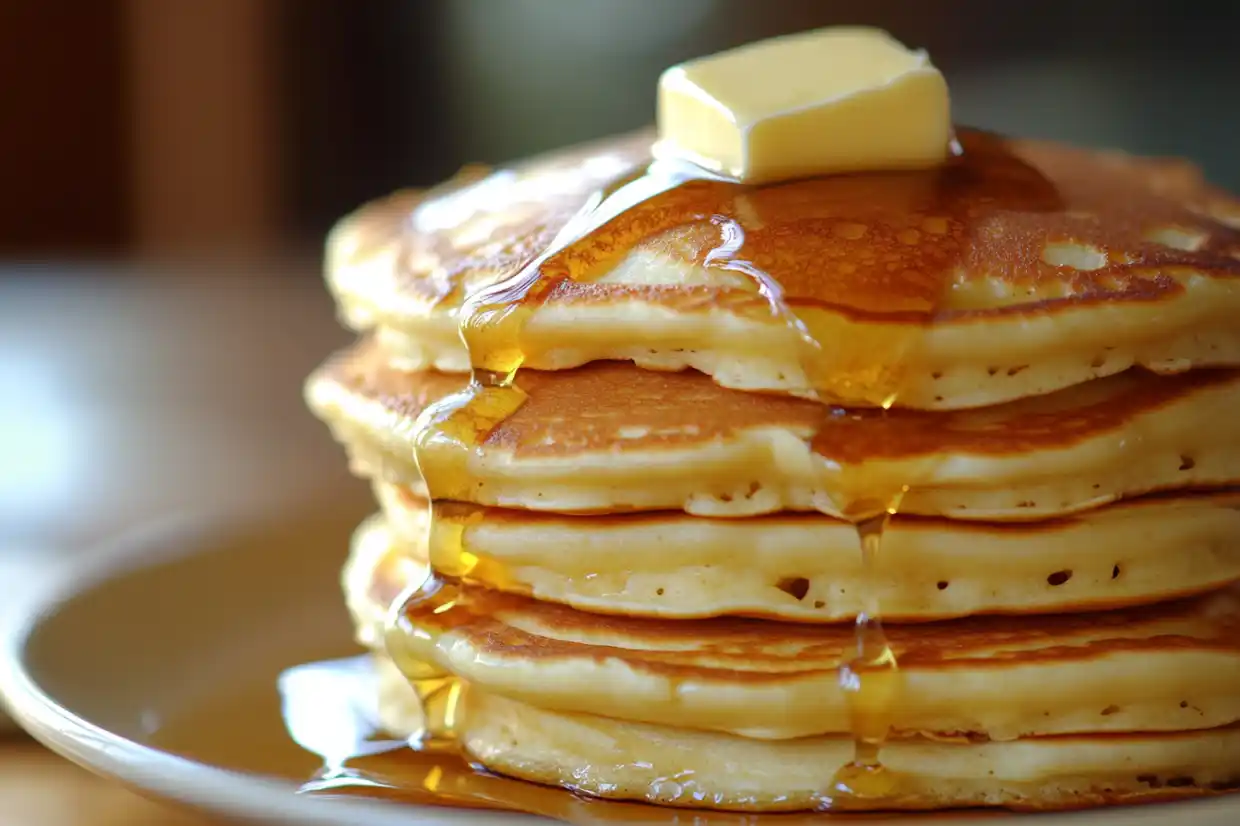There’s something magical about a stack of golden, fluffy pancakes sizzling away in the morning. You know the kind—the ones that make your whole house smell like comfort, happiness, and warmth. Pancakes are not just a breakfast option; they are a beloved tradition in many households. Whether you’re a seasoned pro or a first-time pancake maker, mastering the art of the “Good Old-Fashioned Pancake” is an essential kitchen skill that will always earn you rave reviews.
In this article, we’re diving deep into what makes the perfect stack of pancakes. From understanding the key ingredients to mastering the techniques that turn simple batter into fluffy, melt-in-your-mouth goodness, you’ll find everything you need to whip up the best pancakes ever. Let’s get started with some pancake basics and uncover the secrets that make the “Good Old-Fashioned Pancakes” so delicious!
Table of Contents
Introduction: Why Good Old-Fashioned Pancakes Are Timeless
Pancakes have been around for centuries, and there’s no denying their charm. Whether enjoyed as a quick breakfast or a leisurely weekend brunch, pancakes are a universal comfort food that can be enjoyed in countless variations. What makes the “Good Old-Fashioned Pancakes” recipe so special is its simplicity. With just a few basic ingredients—flour, eggs, milk, and baking powder—you can create something truly magical. But it’s not just the ingredients that matter; it’s the way you bring them together.
Good old-fashioned pancakes are all about balance: the right amount of fluffiness, tenderness, and flavor. They’re not too thick or too thin, but perfectly golden-brown on the outside and soft and airy on the inside. There’s something nostalgic about them, too—whether you’re making them for your family or enjoying them with friends, pancakes have a way of bringing people together.
What Makes a Pancake ‘Old-Fashioned’?
The term “old-fashioned” might sound like a relic of the past, but in the case of pancakes, it simply refers to the traditional recipe that has stood the test of time. Unlike modern pancake recipes that often involve complex ingredients or fancier techniques, good old-fashioned pancakes rely on basic pantry staples to create a simple yet satisfying result. These pancakes are often made without fancy add-ins or complicated steps, which is why they are so beloved.
The History Behind Old-Fashioned Pancakes
Pancakes, in one form or another, have been around for centuries. They’ve been made from grains like oats, barley, and wheat, and have been prepared in different ways depending on the region. In the United States, the pancake as we know it today—fluffy, round, and made from a batter—became popular in the 19th century. Early settlers used cornmeal for a more rustic pancake, but as time passed, flour became the preferred choice for making light, airy pancakes. Over the years, this humble recipe has evolved, but the “good old-fashioned” method remains the gold standard.
Key Ingredients for Perfect Old-Fashioned Pancakes
Making the perfect stack of pancakes starts with understanding the role of each ingredient. While there are many variations on pancake recipes, good old-fashioned pancakes are made with just a few simple ingredients: flour, eggs, milk, baking powder, and butter (or oil). Let’s take a closer look at what each ingredient does and how it contributes to the texture and flavor of the pancake.
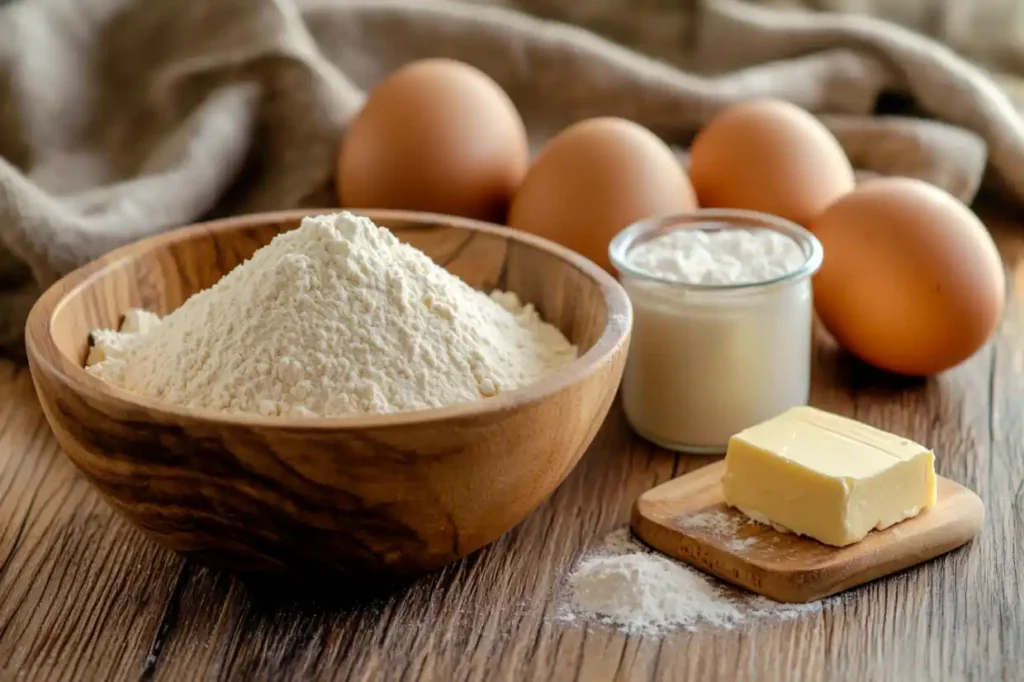
Flour: The Foundation of Pancakes
Flour is the backbone of any pancake recipe. It provides the structure that holds the pancakes together. For the fluffiest pancakes, all-purpose flour is typically used. You can also use whole wheat flour for a slightly heartier, nuttier flavor, but this will change the texture of your pancakes. The key is to measure your flour properly (use a spoon to fill the cup and level it off) to ensure your pancakes aren’t too dense.
Eggs: Binding Everything Together
Eggs act as the binder in pancake batter, helping to hold all the ingredients together. They also add moisture, which is key to creating a soft, tender texture. Don’t skip the eggs—they are essential for giving your pancakes their structure and richness.
Milk: Achieving the Right Consistency
Milk adds the right amount of liquid to the pancake batter, ensuring it’s pourable but not too runny. Whole milk is often preferred, as its fat content helps create a creamier batter, but you can use any milk you like—dairy or non-dairy alternatives will work just fine. The consistency of the batter is important; it should be thick but still able to spread when poured onto the griddle.
Baking Powder: The Secret to Fluffiness
Baking powder is the magic ingredient that makes pancakes rise and become light and fluffy. This leavening agent releases carbon dioxide when mixed with the wet ingredients, causing the batter to puff up as it cooks. Make sure your baking powder is fresh, as expired baking powder will result in flat, dense pancakes.
Butter or Oil: Adding Richness and Flavor
Butter or oil adds richness and flavor to pancakes, helping them cook evenly and providing a golden, crispy exterior. While butter gives a slightly richer flavor, oil is a great alternative if you’re looking for a lighter, less greasy result. Either way, don’t skip this ingredient—it’s key to getting that perfect texture and taste.
Instructions for Making the Perfect Old-Fashioned Pancakes
Now that we’ve gathered all the key ingredients for the perfect pancake batter, it’s time to turn our attention to the cooking process. Making pancakes may seem simple, but the technique matters! Let’s break down the steps for making old-fashioned pancakes that are light, fluffy, and full of flavor.
Step 1: Preparing Your Pancake Batter
The first step in making old-fashioned pancakes is preparing the batter. This is where the magic begins. Start by combining your dry ingredients in one bowl—flour, sugar, baking powder, and a pinch of salt. Mixing these dry ingredients together ensures that the baking powder and salt are evenly distributed, which helps your pancakes rise uniformly.
In a separate bowl, whisk together your wet ingredients—milk, eggs, and melted butter (or oil). Whisk until the mixture is smooth and well combined. Then, gradually add the wet ingredients to the dry ingredients, stirring gently with a spoon or whisk until just combined. Be careful not to overmix! Overmixing the batter can lead to tough pancakes. A few lumps are okay. Remember, the key to soft and fluffy pancakes is not overworking the batter.
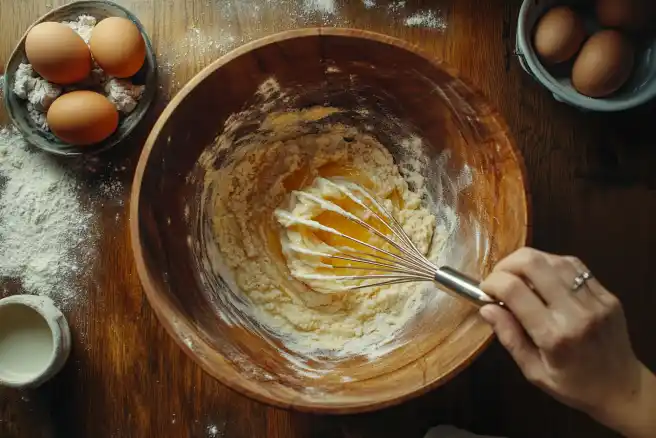
Pro tip: If you find that the batter is too thick, you can add a bit more milk to loosen it up. On the other hand, if it’s too runny, sprinkle in a little extra flour.
Step 2: Preheating Your Pan or Griddle
While the batter is resting for a moment, it’s time to get your cooking surface ready. Whether you’re using a griddle or a skillet, it’s important to preheat your pan over medium heat. This ensures that the pancakes cook evenly and don’t stick. You can test if the pan is hot enough by sprinkling a few drops of water on the surface—if they sizzle and dance, your pan is ready!
Next, add a small amount of butter or oil to the pan and let it melt. The butter adds flavor and helps create that crispy golden-brown exterior. Just be sure not to overdo it—too much butter can lead to greasy pancakes.
Step 3: Cooking Your Pancakes to Perfection
Once your pan is preheated, it’s time to cook the pancakes! For each pancake, pour about 1/4 cup of batter onto the hot griddle or skillet. You’ll want to leave some space between each pancake so they have room to spread. If you’re making a batch, it’s usually best to cook 2 or 3 at a time.
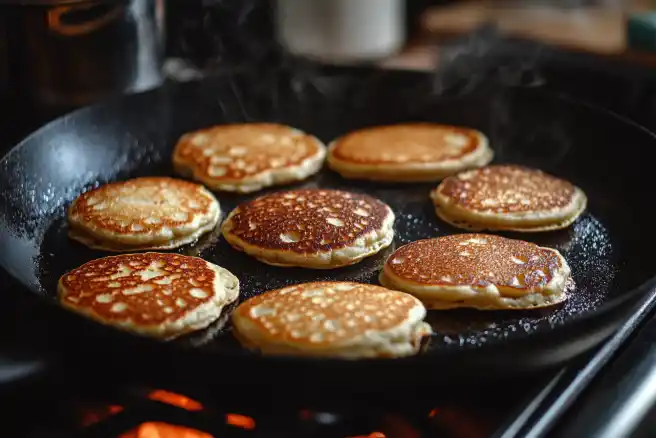
Pro tip: Use a measuring cup or ladle for consistent-sized pancakes that cook evenly.
Now, let the pancakes cook without disturbing them for about 2-3 minutes. You’ll notice small bubbles forming on the surface. This is a good sign! It means the pancakes are ready to flip. Once the bubbles start to pop, gently flip the pancake using a spatula. Be sure to flip it over quickly and confidently to avoid breaking the pancake.
Cook the second side for another 1-2 minutes, or until it turns a beautiful golden-brown color. The pancakes should be firm to the touch but still soft on the inside. If you’re unsure, you can always test one pancake by cutting it open to check if it’s fully cooked.
Step 4: Flipping and Serving
Once your pancakes are cooked, it’s time to stack and serve! Place the pancakes on a plate and cover them loosely with foil to keep them warm while you finish cooking the rest of the batch. If you’re feeling extra indulgent, you can add a little extra butter on top of the stack for added richness.
Now for the fun part—toppings! You can serve your pancakes with a wide variety of toppings, from classic maple syrup to fresh berries, whipped cream, chocolate chips, or even a dollop of peanut butter. The possibilities are endless! Whether you go for a classic syrup drizzle or try something new, the perfect pancake is a canvas for your creativity.
Pro tip: Keep your pancakes warm in a low oven (around 200°F) if you’re making a large batch for a family or group.
Now that you know how to prepare the batter, cook the pancakes, and serve them with flair, let’s talk about common problems and solutions that can arise during pancake-making. Every cook has faced a challenge or two in the kitchen, and pancakes are no exception. Below, we’ve highlighted some of the most common problems people run into and provided easy fixes.
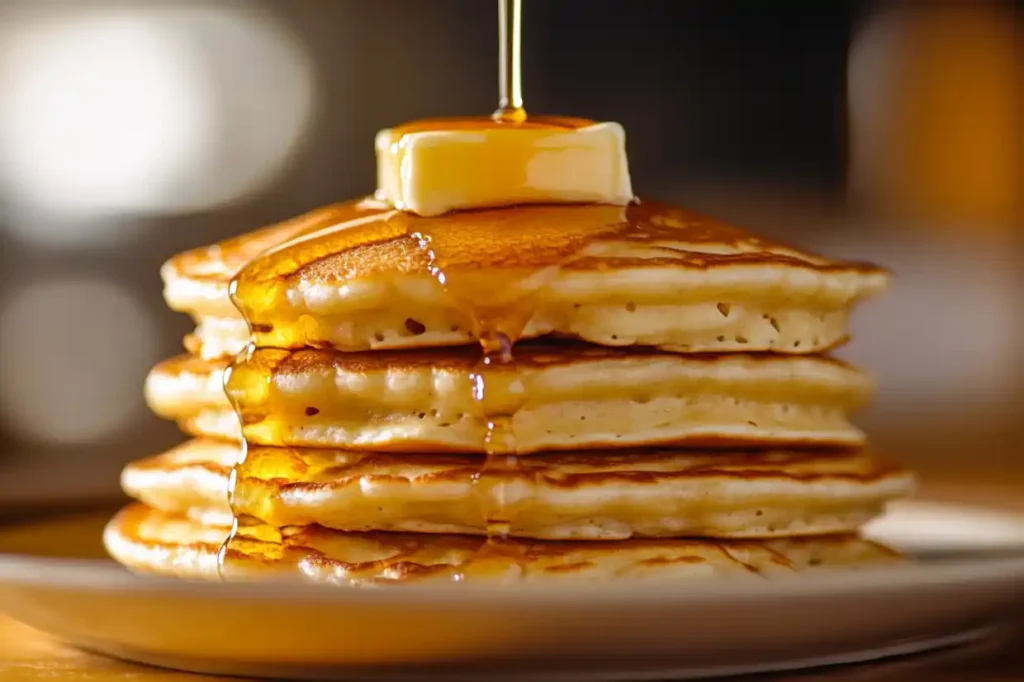
Common Problems and Solutions When Making Pancakes
Problem: Pancakes Are Too Flat or Dense
One of the most common problems people face when making pancakes is ending up with flat, dense pancakes instead of the light, fluffy ones they’re hoping for. This can happen for a variety of reasons, but the most common culprits are either using too much flour or not enough leavening agents (baking powder).
Solution: The Importance of Proper Leavening and Resting the Batter
To avoid dense pancakes, be sure to measure your flour accurately. Also, don’t skip the baking powder—it’s the key to making your pancakes rise and become light and fluffy. If your baking powder is old, it might not work as well, so always check the expiration date. Additionally, letting the batter rest for about 5 minutes before cooking allows the flour to fully hydrate and the gluten to relax, which can help with fluffiness.
Problem: Pancakes Are Too Greasy or Oily
Another common issue is when pancakes turn out too greasy or oily, leaving an unpleasant aftertaste or texture. This can happen if you use too much butter or oil when cooking, or if the pan is too hot.
Solution: Proper Pan Temperature and the Right Amount of Butter or Oil
To avoid greasy pancakes, be sure to use only a small amount of butter or oil, just enough to coat the bottom of the pan. Also, make sure your pan is at the right temperature. If the pan is too hot, the pancakes will cook too quickly on the outside, leaving them oily and undercooked inside. If it’s not hot enough, the pancakes will soak up more butter and oil than they need.
Problem: Pancakes Stick to the Pan
Pancakes sticking to the pan can be frustrating and result in uneven cooking or ruined pancakes.
Solution: How to Use Nonstick Pans or Properly Grease Your Pan
Using a nonstick pan or griddle is one of the easiest ways to avoid sticking. If you’re not using nonstick cookware, make sure to grease your pan with a small amount of butter or oil and spread it evenly. You can also use a paper towel to wipe off any excess grease, as too much fat can make the pancakes greasy.
Problem: Pancakes Are Too Dry
Dry pancakes are another common issue, often caused by too much flour or not enough liquid in the batter.
Solution: Adjusting the Liquid-to-Dry Ingredients Ratio
To make sure your pancakes stay moist and tender, be mindful of the liquid-to-dry ingredient ratio. If your batter seems too thick, add a little more milk to loosen it up. On the other hand, if it’s too runny, add more flour in small amounts until you achieve the right consistency.
Tips and Tricks for Enhancing Old-Fashioned Pancakes Flavor
While the basic recipe for good old-fashioned pancakes is fantastic on its own, there are plenty of ways to elevate your pancake game. With just a few simple tweaks and additions, you can take your pancakes from good to extraordinary. Let’s dive into some tips and tricks that will have your pancakes tasting better than ever before!
Adding Vanilla or Cinnamon for Extra Flavor
Vanilla and cinnamon are two of the easiest ingredients you can add to boost the flavor of your pancakes. A splash of vanilla extract will give your pancakes a sweet, warm flavor that pairs perfectly with maple syrup. It’s a small addition, but it makes a big difference. Similarly, a pinch of cinnamon can add a nice, aromatic touch to the batter, giving your pancakes a hint of spice that feels cozy and comforting. You can even combine both vanilla and cinnamon for a rich, layered flavor profile.
Tips for Perfect Pancakes Every Time
Achieving the perfect texture and flavor is all about balance and timing. One of the best ways to ensure your pancakes turn out perfectly is by using the right tools. A good quality non-stick skillet or griddle can make a huge difference. Also, always make sure your batter isn’t over-mixed, as this can lead to dense pancakes rather than light and airy ones.
For an even healthier twist on your pancakes, try the Healthy Protein Packed Premier Protein Pancakes for a delicious and protein-packed option that’s still just as satisfying.
Making Pancakes with Bisquick
For those in a hurry, How to Make Bisquick Pancakes: Ultimate Guide is a fantastic shortcut. Bisquick pancakes are quick to make while still offering the fluffy texture of their homemade counterparts.
Pro tip: If you want to take it a step further, try adding a dash of nutmeg or allspice for even more complexity!
Using Buttermilk for a Tender Texture
Buttermilk is a classic ingredient that many traditional pancake recipes call for—and for good reason. Buttermilk gives pancakes a slightly tangy flavor and makes them extra tender. It reacts with the baking powder, helping the pancakes rise more effectively and creating a delicate, airy texture. If you don’t have buttermilk on hand, you can make your own by adding a tablespoon of lemon juice or white vinegar to a cup of milk and letting it sit for 5 minutes. The result will be very similar to using store-bought buttermilk.
Enhancing with Mix-ins like Blueberries or Chocolate Chips
While old-fashioned pancakes are simple and delicious on their own, adding mix-ins is a great way to personalize your pancakes. Blueberries are a classic choice, adding sweetness and juiciness that pair perfectly with the soft pancakes. You can fold the blueberries into the batter before cooking, or you can drop them onto the pancake while it’s cooking on the griddle, pressing them gently into the batter. If you’re craving something a little more indulgent, chocolate chips are another great option. They melt perfectly into the pancakes as they cook, creating pockets of gooey, chocolaty goodness.
Pro tip: For an extra pop of flavor, try adding banana slices, chopped nuts, or even a swirl of peanut butter or Nutella into the batter. The possibilities are endless!
Experimenting with Different Toppings
The toppings you choose can make a huge difference in how your pancakes taste. Classic maple syrup is a favorite, but there’s no need to stop there! Consider topping your pancakes with whipped cream, fresh fruit, a drizzle of honey, or a spoonful of peanut butter. If you’re in the mood for something more decadent, you can try a dusting of powdered sugar or even a generous scoop of vanilla ice cream for a dessert-style treat.
For a savory twist, you could add bacon or sausage on the side or even drizzle your pancakes with a bit of maple syrup and sprinkle with cheese for an unexpected combination of flavors.
Now that we’ve covered how to enhance your pancakes, let’s answer some of the most frequently asked questions about pancakes. Whether you’re wondering about the secret to the fluffiest pancakes or why restaurant pancakes taste better, we’ve got the answers for you.
FAQ: Common Questions About Old-Fashioned Pancakes
What is the secret to good pancakes?
The secret to good pancakes lies in the right balance of ingredients and technique. First, use fresh baking powder to ensure your pancakes rise and become fluffy. Don’t overmix the batter—lumps are okay! And make sure your pan is at the right temperature. A medium heat is ideal for cooking pancakes evenly without burning them. Finally, be patient and let the pancakes cook until you see bubbles on the surface before flipping them.
Pro tip: Resting the batter for a few minutes before cooking can also make a big difference in the texture of the pancakes.
What are the ingredients in old-fashioned pancakes?
The ingredients for good old-fashioned pancakes are simple and straightforward: flour, sugar, baking powder, salt, eggs, milk, and butter (or oil). These basic ingredients come together to create a soft, fluffy pancake that’s perfect for any breakfast or brunch.
Pro tip: You can customize the recipe by adding ingredients like vanilla, cinnamon, or buttermilk to take your pancakes to the next level!
Why do restaurant pancakes taste better than homemade?
Restaurant pancakes may taste better for a couple of reasons. First, they often use professional-grade equipment, like large, well-maintained griddles that cook pancakes evenly. Second, many restaurants use a combination of ingredients like buttermilk, or even a secret blend of flour, to create a lighter, fluffier texture. Additionally, restaurant pancakes tend to be made in larger batches, which allows for more consistency and speed in cooking.
At home, you can get similar results by ensuring your pan is at the right temperature, using fresh ingredients, and being mindful of your batter’s consistency.
What makes pancakes taste better?
The flavor of pancakes can be enhanced by the ingredients you choose and the toppings you use. Adding vanilla extract or cinnamon to the batter gives it extra flavor, while using buttermilk or sour cream will create a tender texture. As for toppings, the sky’s the limit—fresh fruit, syrup, whipped cream, or even a sprinkle of sugar can elevate the taste and make your pancakes feel more indulgent.
Pro tip: Try mixing in fresh berries or chocolate chips into the batter for an added burst of flavor in every bite.
Conclusion: Mastering the Good Old-Fashioned Pancakes Recipe
There you have it! The key to making perfect, good old-fashioned pancakes is in the balance of ingredients, the cooking technique, and, of course, a little love and patience. From choosing the right flour to getting the cooking temperature just right, every step plays a role in creating a stack of pancakes that’s light, fluffy, and absolutely delicious.
With the tips, tricks, and answers to common pancake problems that we’ve shared, you’re now ready to make pancakes that will impress your family, friends, or even yourself! So, what are you waiting for? Get cooking and enjoy a delicious plate of pancakes that will make every morning feel like a special occasion.
Pro tip: Don’t forget to get creative with your toppings and mix-ins to customize your pancakes to your liking. Whether you prefer them sweet or savory, the possibilities are endless!
